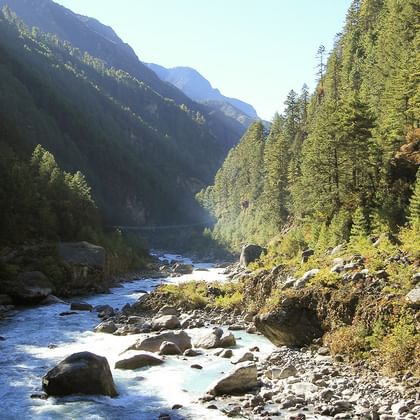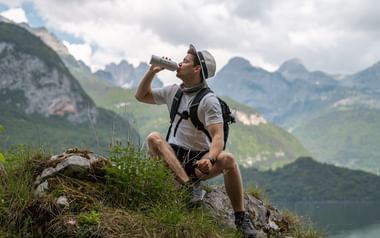Our tours in Nepal
The Kathmandu Valley - only 2500 years ago a gigantic lake - is a truly unique and exotic place. The valley is surrounded by green mountainsides and to the north you can glimpse the majestic snow-capped peaks. 1.8 million people live in the Kathmandu Valley, located at an altitude of 1300 metres. The population is spread across four major cities, each with impressive historical, artistic and cultural landmarks. The cities are called Kathmandu, Patan, Bhadgaon and Kiripur. Until 1769, the four cities were the capitals of the four smaller kingdoms of Kantipur, Lalitpur, Bhaktapur and Kirtipur, which had divided the Kathmandu Valley between them.
The mountainous country of Nepal offers fantastic opportunities for trekking and mountaineering. The country has a magnificent nature with rushing rivers, wild jungle animals and the stunning Himalayan mountain range. This means Nepal has some of the world's best opportunities for walking holidays and mountaineering.
Go trekking or mountaineering in Nepal and be mesmerised by its unique surroundings and amazing people. Experience the incredible views and the fluttering prayer flags that will be a memory for life.
Nepal is an exciting cultural country with temples, gilded monasteries and lively markets. In the capital Kathmandu, the streets are filled with bicycles, cows, cars and street vendors. Meet Nepal's hospitable and curious people and get up close to the culture and nature.
An adventure trip to the only country with a non-rectangular flag is an experience of a lifetime.
Trekking is great in Nepal
If you're into trekking, you can't go past Nepal. We simply believe that Nepal is the best place to trek in the world. For many, many years, goods have been transported around the country carried by people. Therefore, Nepal also has a large system of trails that are suitable for trekking. The trails go through forests, villages and mountains. Trekking in Nepal is simply unrivalled.
The most popular treks in Nepal
Everest
Everest Base Camp Trek is Nepal's most popular trekking route. Thousands of trekkers make the trek to the world's highest mountain every year. The best seasons to do the trek are March-April and October-November. The weather is warm and dry. On our treks to Everest Base Camp we stay in teahouses all the way and it is possible to have all meals on the trek included in the price.
There are several versions of Everest Base Camp. There's the ‘regular’ 18-day trek, which is the route most people take. However, more and more people are discovering what we call the ‘luxury version’, which is Everest Base Camp via Gokyo and the Cho La pass. The luxury element of the trip is that you pass the incredibly beautiful Cho La lake. It really is a great experience.
In addition to the ‘regular’ trip to Everest Base Camp and the ‘luxury version’ via Gokyo, we also have the trip where you go to Everest Base Camp via Jiri. This tour is a week longer than the others because you skip the flight to Lukla at the start of the tour. Instead, you drive to Jiri and start the trek from there. The trip is longer, but there are also some advantages. For example, the acclimatisation is even better than on the other treks - simply because you're slowly climbing the mountains and because the journey up takes longer.
Annapurna
The Annapurna Base Camp Trek is a classic in Nepal and is almost as popular as the trek to Everest. The trek to Annapurna Base Camp is a little easier than the trek to Everest Base Camp and you get to experience just as many amazing things as Everest. Annapurna is best in March-April and October-November.
Manaslu
The trek around Manaslu is probably the most beautiful trek in Nepal. The scenery is marvellous and because it's not quite as crowded as the others, it's also a more authentic experience - though the route is becoming quite popular now. Manaslu is best in March-April and October-November.
Mountaineering in Nepal
Island Peak
Our ascent of Island Peak via Everest Base Camp combines two things that many people want to experience when in Nepal. There's a more direct route to Island Peak, but making the trek a little longer and experiencing Everest Base Camp makes the acclimatisation better and the experience greater. Our Island Peak tours can be booked individually throughout the year, but the peak season is March-April and October-November.
We organise 1-2 group trips to Island Peak each year, where we typically have 6-12 participants on the trip.
Mera Peak
Our Mera Peak climb is a classic. Mera Peak is an easier peak to climb than Island Peak because you don't have to ‘climb’ up and can instead trek all the way to the top. Every year we organise two group trips to Mera Peak - one in spring and one in autumn.
Local guides
On our trips to Nepal, we always use local guides. We do this partly because we believe it's the most sustainable thing to do - Nepalese people should be allowed to earn money showing tourists around their country and partly because the Nepalese guides are highly professional and speak good English.
Meals included
On most of our trekking tours in Nepal, ‘all meals on the trek’ are included in the price. This means that you get three meals a day during the treks. Meals are usually taken at teahouses along the route and there will be a menu to choose from. In Kathmandu, only breakfast is included, so you're free to choose from the many great places to eat.
What to bring to Nepal
Trekking in Nepal requires good equipment and on trips of this calibre, it's not worth skimping on that part of the trip. That's why we've created packing lists to give you a good idea of what you should bring on your trip. See our Everest Base Camp and Gokyo Trekking packing list and our Annapurna Base Camp Trek packing list.
Bering Travel is always available if you have any questions about travelling to Nepal.

We take care of it all
On all our tours to Nepal, we take care of transporting your luggage from hotel to hotel, which is great as it means you can focus on just enjoying the beautiful hiking routes in the area. You'll also always receive a map and route description of the trip, so you can feel completely safe once you're on your way.

